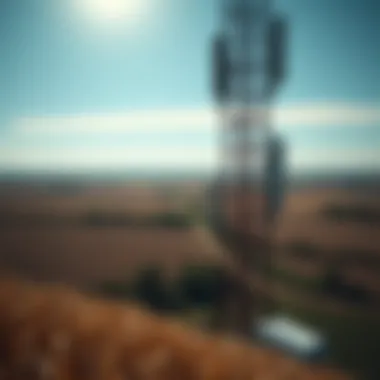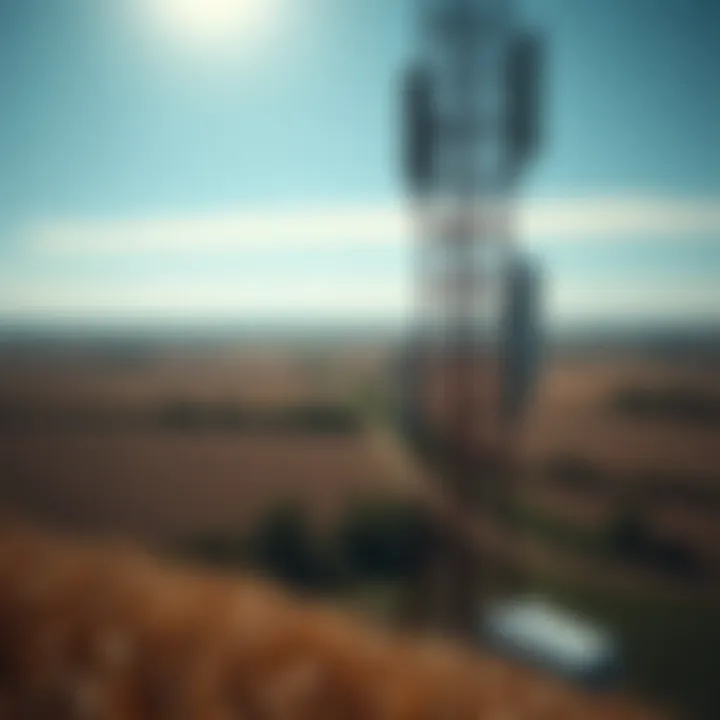Internet Connectivity Solutions for Remote Areas


Key Insights
In the vastness of our world, remote locations often find themselves disconnected from the fast-paced digital life that many take for granted. The internet, being a vital conduit for information, business, and everyday communication, poses significant challenges in these areas. As we delve into the various options available, it becomes essential to understand not only the technology behind these solutions but also the particular needs of those who work in agriculture, horticulture, and agronomy.
Overview of the Topic
When it comes to rural connectivity, the choices are more varied than some might imagine. From satellite internet, which beams data across vast distances, to cellular networks that can penetrate even the most isolated valleys, there's a growing list of options tailored for those off the beaten path. More recently, innovations like fixed wireless systems and community broadband initiatives have also been stepping up to the plate. Each of these technologies harbors its own unique benefits and drawbacks, particularly when we consider factors like cost, reliability, and bandwidth.
Importance in Agriculture/Horticulture/Agronomy
In the sphere of agriculture, reliable internet access has evolved from a luxury to a necessity. Today's farmers leverage technology for everything from market prices to climate data. Here’s why understanding these internet options is crucial:
- Remote Monitoring: Tools for precision agriculture often rely on constant internet connectivity. Sensors and drones that track crop conditions need robust data links to relay information back to farmers.
- Education and Resources: Whether it’s an online seminar or tutorials on sustainable practices, access to knowledge is key for those in the field.
- Market Access: Farmers need to stay updated on market trends and consumer preferences, often directly facilitated through digital platforms.
Sustainable Practices
Eco-Friendly Techniques
This quest for connectivity also has to consider the environmental impact. Many rural internet solutions are now being designed with sustainability in mind. For example, solar-powered routers can be crucial for regions where electricity is inconsistent. Such renewable solutions alleviate some strains on the grid while also promoting a greener footprint.
Case Studies on Sustainability
Consider the initiative in Wisconsin, where a cooperative of farmers banded together to develop a supplemental internet network powered by wind energy. This local solution brought connectivity to their farms while demonstrating how community collaboration can yield sustainable solutions.
Tools & Resources
Essential Equipment and Technologies
To truly take advantage of the internet options at hand, certain tools and equipment are essential:
- Satellite Dish: Needed for satellite internet.
- Modem/Router: For connecting devices within the home or farm.
- Mobile Hotspot: Useful in areas where cellular reception is available.
Recommended Books and Readings
Interested farmers might find value in educational resources such as:
- The Farm Internet: What you need to know by Laura McDonald
- Tech Tools for Modern Agriculture by Adam Turner
Staying informed is crucial for navigating the ever-evolving landscape of connectivity.
Final Thoughts
As we wrap up this exploration, it's evident that the way forward for those in remote locations is not just about choosing between options, but envisioning what connectivity means to their lives and businesses. Each decision made can lead to a future where isolation becomes a thing of the past. For further insights, consider perusing resources from Wikipedia or agricultural forums like Reddit for community-driven discussions.
"The future belongs to those who prepare for it today." - Malcolm X
For more detailed info, check out these resources:
- Wikipedia - Internet Access
- USDA - Connectivity
- National Agriculture Statistics Service - Internet Use
Understanding Connectivity in Remote Areas
In today's fast-paced world, being connected is not just a luxury but a necessity, especially for those inhabiting remote locales. Understanding how connectivity operates in these areas is foundational to comprehending the various internet options available. It is critical not just for personal use but also for boosting agricultural productivity, accessing vital information, and enhancing communication within communities. The basic premise revolves around the fact that poor connectivity can stifle growth and limit opportunities.
Though the digital landscape is changing at lightning speed, remote areas often lag behind urban centers in internet access. This divide highlights an essential need for tailored solutions that address the specific conditions of rural environments. The benefits of solid connectivity include improved access to resources, increased efficiency, and the possibility of engaging in an increasingly digital economy. In very practical terms, farmers can monitor crops, access weather updates, and even sell products online, which aids in decision-making.
Beyond simply getting online, connectivity also brings up considerations about reliability and speed, which can directly influence everything from crop yields to business growth. In addition, understanding network infrastructure can aid in choosing the right technology to meet individual needs, whether that’s satellite service, cellular networks, or other options. If remote residents can fathom these elements, they are better equipped to advocate for the internet solutions that cater to their specific situations.
The Importance of Internet Access
Internet access in remote areas serves as a lifeline, specifically for agricultural professionals and enthusiasts. Reliable connectivity means access to critical information and services. For instance, agricultural weather forecasts and market prices can be vital for planning and resource allocation. The straightforward truth is that lacking internet access makes it harder to compete. Think of it as being an island in an ocean of information; having no way to surf those waves limits growth.
Moreover, connectivity can drive community development. With online access, local businesses can expand their reach and enhance their market presence. This not only contributes to economic growth but also bolsters community ties through social media platforms and communication tools. It's the digital equivalent of having a town meeting, just online and with a broader audience.
In many cases, the absence of internet access can lead to isolation, making it difficult to stay informed or to connect with others who share similar challenges and interests. By contrast, having internet in more remote areas allows for the possibility of collaboration and shared learning experiences, fostering innovation and sustainability.
Challenges of Remote Connectivity
Despite the clear advantages, achieving consistent connectivity in remote areas comes with its own set of hurdles. One significant challenge is the geographical terrain. Hills and valleys can obstruct signals, rendering certain locations nearly unreachable by traditional internet services. It’s a bit like trying to get a radio signal in a basement; sometimes, the location just won’t cooperate.
Moreover, the cost of infrastructure development can be prohibitive. Companies are less likely to invest in laying lines or towers in sparsely populated areas, as the payoff may not justify the expenditure. This results in limited options for locals, leaving them relying on less effective means or outdated technology.


Another hurdle is regulatory issues. Specific laws or regulations can complicate the rollout of new services. Get tangled up in red tape, and even innovative solutions may struggle to find a foothold.
In sum, understanding both the importance and the challenges of connectivity in these remote areas is crucial. It sets the stage for exploring various internet options better suited to tackle these conditions, ultimately enhancing connectivity for those who most need it.
Satellite Internet Services
Satellite internet has emerged as a pivotal solution for achieving connectivity in remote regions, a lifeline for many farmers and agricultural enthusiasts. In contrast to other forms of internet, satellite technology provides a wide-reaching alternative that can cover vast and isolated areas where traditional lines may never reach. Let’s dive deeper into understanding how satellite internet operates, explore its key service providers, and weigh its benefits against its drawbacks.
How Satellite Internet Works
The mechanics of satellite internet are surprisingly straightforward yet sophisticated. Essentially, what happens is that a satellite in orbit beams signals to a dish installed at the user’s location. This dish, often referred to as a satellite terminal, transmits data to the satellite, which then routes this data through ground stations and back to the broader internet.
- Signal Transmission: These satellites operate in geostationary orbits—approximately 22,236 miles above the Earth—allowing them to maintain a fixed position relative to the planet.
- Latency Concerns: Users may notice some latency; because the signals have to travel such long distances, there can be a noticeable delay in communication. This can be a significant factor for real-time applications.
Despite this, satellite internet stands as one of the best options for those living far from urban centers. It can bring the world of connectivity to the most desolate farms, enabling data transfer and real-time communication with service providers, supply chains, or even agricultural tech programmers.
Leading Satellite Providers
When considering satellite internet service, it’s essential to know the players in the field. Here are some well-known providers that have made strides in connecting rural users:
- HughesNet: This provider is one of the largest satellite internet services in the U.S. They offer plans with various data options and have been notable for their residential and business plans tailored to remote users.
- Viasat: Known for providing higher speed options compared to others, Viasat aims at both residential customers and commercial clients, focusing on areas with limited local internet infrastructure.
- Starlink: A recent entrant in the market thanks to SpaceX, Starlink aims to provide high-speed internet through a constellation of low-Earth orbit satellites. With ongoing launches, it promises reduced latency and improved service.
Each of these providers has distinct offerings, so it’s prudent for users to compare options based on speed, coverage areas, and pricing.
Advantages and Limitations
Advantages:
- Accessibility: One of the most undeniable benefits of satellite internet is its ability to reach areas where no other type of connection is possible. For locations lacking fiber optic or cable infrastructure, satellite becomes invaluable.
- Easy Setup: The installation is fairly simple, often requiring just a satellite dish and a modem, with many providers offering professional setup assistance.
- Wide Coverage: Unlike terrestrial networks that are limited by physical geography, satellites can provide service to virtually anywhere on the globe, making rural connectivity feasible.
Limitations:
- Latency Issues: As mentioned earlier, the distance from the satellite can lead to high latency—meaning that for activities that require instant feedback, such as gaming or high-frequency trading, this may become problematic.
- Weather Sensitivity: Signal quality can degrade during severe weather conditions like storms or heavy snowfall, affecting service reliability.
- Price Points: Satellite internet often comes with higher monthly fees compared to other solutions like cable or DSL, primarily due to the cost of satellite launch and maintenance.
Ultimately, embracing the right internet solution can enhance productivity and resource management in agriculture, paving the way for smarter farming strategies.
Cellular Network Solutions
In the ever-evolving landscape of technology, cellular network solutions hold significant importance, especially for those residing in remote locations. These technologies bridge the gap, connecting individuals to the wider world, enabling not just communication but also access to vital resources and information. For farmers and agricultural enthusiasts, having a reliable internet connection is not a luxury; it’s a necessity. Whether it’s monitoring crop health, managing equipment remotely, or accessing market prices, connectivity can be the difference between thriving and merely surviving.
Understanding Cellular Coverage
Cellular coverage is the backbone of any mobile communication, and understanding its intricacies is crucial in remote areas. Cellular networks operate through a series of towers that send and receive signals from devices such as mobile phones and tablets. In isolated regions, it’s vital to assess how far one’s location is from these towers, as this distance directly impacts signal strength and overall connectivity.
Generally, these towers cover areas based on their height and the technology they utilize. The line of sight can often be an issue; hills, trees, or buildings can obstruct signals. Rural communities may find themselves at a disadvantage due to fewer cell towers available. Expandability is another critical consideration. While one might get good coverage today, there’s always the question of future development in the area. It’s beneficial for farmers to be aware of the cellular provider’s plans for expansion.
Comparing 4G and 5G Technologies
When discussing cellular solutions, the comparison between 4G and 5G technologies is in the spotlight. 4G has been the go-to for quite some time, providing decent speed and reliability. A step up, 5G is not only about speed but also about lower latency and supporting many connected devices simultaneously. This becomes particularly relevant in agricultural settings where IoT devices manage numerous tasks from irrigation to livestock monitoring.
In terms of practical impact, farmers using 4G may encounter speeds around 10-100 Mbps in optimal conditions. On the flip side, 5G can potentially reach speeds exceeding 1 Gbps. However, the rollout for 5G is still underway in many areas, and sometimes is limited based on regional infrastructure. Therefore, it’s essential for users to weigh the current benefits of 4G against the anticipated advantages of 5G.
Mobile Hotspots as a Solution
For those in rural settings, mobile hotspots emerge as a viable solution when conventional connectivity options fall short. These devices allow users to share their cellular data connection with multiple devices, transforming a phone’s 4G or 5G signal into a Wi-Fi zone. Farmers can utilize mobile hotspots effectively when they’re out on the field or in areas lacking stable coverage.
When choosing a mobile hotspot, one should consider factors such as:
- Data allowance: Ensure that it aligns with your internet consumption needs.
- Battery life: Farming can keep you busy; you want a device that can last all day.
- Coverage: Check if the provider offers good coverage in your required areas.
With these devices, farmers can access online resources, communicate with partners, and make informed decisions while on the go.
"Connectivity isn’t just a commodity for remote locations; it's the lifeline that enables innovation and sustainability in modern agriculture."
In summary, cellular network solutions extend far beyond mere access; they present opportunities for efficiency and growth in agricultural practices. Understanding the strengths and weaknesses of cellular coverage, comparing 4G and 5G technologies, and recognizing mobile hotspots as a practical solution can make a substantial difference for those in remote areas. By keeping this knowledge in mind, individuals can enhance their connectivity options, ultimately leading to improved productivity and success.
Fixed Wireless Internet
In the quest for reliable internet solutions, especially in remote landscapes, Fixed Wireless Internet stands out as a noteworthy option. Unlike traditional cable or fiber optics, this technology uses radio signals to provide internet connection. Such a method caters particularly well to locations where physical wires may not reach or be cost-effective to lay down. For agricultural professionals, having access to stable online resources can enhance efficiency, whether it's accessing weather reports, market data, or using precision farming technologies.
Overview of Fixed Wireless Technology
Fixed Wireless Technology employs a system of antennas to transmit and receive data. The setup typically involves a tower positioned within a certain range of the user's location, which, in turn, connects to a broadband internet source. Signals travel via radio waves rather than infrastructure-heavy cabling. In many ways, it's similar to how cell phones work, just without the mobile aspect.


The technology is especially beneficial for people in isolated areas where traditional internet options are scarce. The installation process tends to be quicker compared to wired solutions; the hardware often consists of a small dish installed on the house or building, which can be up and running in no time. This makes it a viable solution for farmers who may need immediate internet access to manage tasks in their operations efficiently.
Rollout and Availability
Despite its advantages, Fixed Wireless Internet isn't universally available. The deployment relies heavily on infrastructure, and while it has seen a rise in popularity, availability can still be spotty in various locations. This often results from the topography and the presence of tall buildings or vegetation that can interfere with signal propagation.
In many rural areas, local service providers may take the initiative to install the necessary infrastructure to meet demand. Still, the level of service can differ significantly between regions. In some areas, you're just a nod from the local office to get connected, whereas in others, it might feel like pulling teeth. It's worth contacting local providers to assess exact offerings and potential coverage maps, which can generally be found on their websites.
Pros and Cons of Fixed Wireless
Pros:
- Rapid Deployment: Installation is quicker compared to wired solutions, enabling faster access to the internet.
- Less Infrastructure Maintenance: It reduces the burden of physical wiring for distant areas.
- Cost-Effective for Sparse Populations: The overall cost can be lower when targeting remote, sparsely inhabited areas.
Cons:
- Signal Interference: Buildings, trees, and hills can obstruct signals, affecting reliability.
- Limited Speeds Compared to Fiber: While decent, speeds often can't compete with fiber-optic internet.
- Dependence on Service Provider: If your chosen provider is running into operational issues, your connection might suffer as a result.
Many remote agricultural operations can greatly benefit from consistently reliable internet, making Fixed Wireless a worthy consideration for their connectivity needs.
In summary, Fixed Wireless Internet offers a unique solution tailored to the requirements and realities of those in remote areas. For farmers and enthusiasts aiming to bolster their operational efficiency, considering this technology could be a solid step towards better connectivity.
Community Networks
Community networks are popping up across the globe and are becoming a hot topic as we dive into options for internet connectivity in remote areas. These networks are different from traditional internet services. They bring together individuals within a community to build and share their own internet resources. This is especially key for rural areas where commercial offerings fall short. With growing interest in agriculture and local entrepreneurship, community networks can empower residents to access vital information, market their goods, and even connect with broader markets online.
One of the most substantial benefits of community networks is the collaborative nature. Residents contribute resources, whether it's funding, technical skills, or even physical infrastructure like towers and antennas. This shared responsibility reduces costs and increases resilience against outages often experienced with centralized providers. Importantly, these networks can adapt to the community's specific needs, prioritizing local content and services.
However, establishing such a network isn't necessarily smooth sailing. It requires a level of community engagement and ownership. Ensuring that community members are on board and understand the benefits is crucial. Additionally, there are various technical considerations. Participants must decide on the right technology to use, whether it's Wi-Fi mesh, long-range radio, or even fiber optics, depending on their geographical and financial constraints.
Here's a brief list of important parts when considering to set up a community network:
- Community agreement on goals and project scope.
- Skill assessment among community members to identify who can manage aspects of the network.
- Funding sources, such as grants or local sponsorships.
- Technology selection that fits the community's needs and environment.
"The key to a successful community network is a strong foundation of collaboration and a shared vision."
As agricultural communities strive to digitalize their operations, these networks can serve as the backbone for transforming traditional practices into innovative agricultural methods. Enhanced internet access allows for better weather forecasting, precision farming, market updates, and more—all crucial factors that contribute to efficient agribusiness.
Ultimately, community networks present a unique opportunity. They not only enhance internet reach but also foster a sense of solidarity and cooperation among residents, allowing them to thrive together. As the world continues to embrace digital connectivity, these networks could become the unsung heroes in the quest for comprehensive internet access in rural locales.
Establishing Community-Based Internet
Starting a community-based internet initiative entails meticulous planning. It often begins with a vision laid out by a small group of passionate individuals who understand the importance of connectivity. The first step is to assess whether there’s a demand for the service. Surveys, focus groups, or community meetings can shed light on the potential benefits perceived by residents. Once support is gathered, they need to map out the area and identify spots for optimal coverage.
Technical feasibility studies would greatly help in determining whether infrastructure can be realistically established given local topography and urbanization.
Funding is another critical hurdle. Community networks often have to rely on a patchwork of financial support from various sources. Grants from government programs, nonprofit organizations, or even local businesses can provide the initial capital required. Once funding is secured, the next stage involves technical training: equipping local residents with the skills needed to maintain the network.
Case Studies of Successful Networks
Several communities have successfully established their own networks, showcasing the potential of this approach. Take, for example, the Freifunk initiative in Germany, which has brought together neighborhoods to create their own free wireless internet. This model not only expanded access but also turned into a social movement, empowering citizens to take charge of their digital environment.
In the United States, the Louisiana Community Network initiative stands out as well. Following Hurricane Katrina, locals craved more reliable communication channels. By pooling resources and expertise, they built a community-driven network that continues to evolve and serve local needs.
Key takeaways from these case studies include the importance of fostering community spirit and the necessity for ongoing engagement to address challenges as they arise. Each successful network offers a model for others, not just in terms of technology but also in terms of community mobilization and support.
For more insights, you can check sites like Wikipedia or visit forums on Reddit for discussions among community members sharing their experiences.
By drawing lessons from these case studies, other rural or underserved areas can rethink their approach to connectivity and consider establishing similar initiatives.
Emerging Technologies
Emerging technologies are fast becoming the lifeline for those in remote regions, especially agricultural professionals who depend on reliable internet connectivity to make informed decisions and enhance their workflow. The significance of this section lies in exploring how innovative solutions can overcome traditional barriers to connection in these isolated areas. These advancements not only improve digital accessibility but also have the potential to revolutionize agricultural practices, thereby boosting productivity and sustainability.
Low Earth Orbit Satellites
Low Earth Orbit (LEO) satellites represent a true breakthrough in bridging the digital divide. Unlike traditional satellites that hover in geostationary orbit miles above the earth, LEO satellites orbit at lower altitudes, often just a few hundred kilometers up. This reduced distance translates to lower latency—crucial for applications in farming where real-time data can greatly impact decisions.
Consider the case of a farmer using precision agriculture tools that rely on satellite data for optimizing irrigation schedules. The timely and reliable connection provided by LEO satellites can mean the difference between abundant harvests and crop failures. For instance, SpaceX's Starlink has been lauded for it’s ability to deliver high-speed internet even in the most challenging terrains, providing a lifeline for farmers who previously had little to no connection.
"LEO satellites could transform rural connectivity, giving farmers the tools they need to manage their operations efficiently."
The advantages are evident, but there are still considerations to weigh. The installation of ground stations and necessary infrastructure can involve hefty initial costs. Moreover, the regulatory landscape is still evolving as governments seek to accommodate this new technology.


Future of Wireless Communication
The future of wireless communication looks particularly promising, especially with advancements beyond conventional connectivity methods. Wireless communication is evolving rapidly, with new standards and technologies like 5G promising unprecedented speeds and reliability. This can enable farmers to use technologies like automated drones for crop monitoring or IoT devices for soil management.
Imagine a network of sensors scattered across a farm that communicates data back to a central system in real-time. This setup can help farmers track soil moisture and nutrient levels with pinpoint accuracy, leading to better resource management. Furthermore, personalized data analytics powered by cloud services can provide tailored insights for individual farming operations.
Nevertheless, with innovation comes the need for education. Farmers will need guidance on leveraging these new technologies effectively. Training sessions and workshops could serve a vital role in this regard, enabling users to maximize the benefits of these emerging technologies and, in turn, improve agricultural outputs.
Cost Considerations
In any venture, especially in agriculture where every penny counts, understanding cost considerations for internet options in remote locations is crucial. With connectivity now a lifeline for modern farming, having a grasp on costs helps farmers and enthusiasts make informed choices about their internet solutions. This section digs into the elements that play a significant role in budgeting and evaluating internet services.
Budgeting for Internet in Remote Areas
When budgeting for internet in remote areas, one first must list all potential expenses. It’s not just about the subscription fees; hidden costs creep in too. Here are a few elements to consider:
- Installation Fees: Many services, particularly satellite and fixed wireless, require installation. This might mean paying for technicians or equipment setup.
- Equipment Costs: If you opt for cellular internet, you might need a quality router or modem. For satellite, you need a dish and possibly a receiver. Each of these can deliver a hit to your pocket.
- Service Plans: Different providers offer varying plans. Some might look attractive upfront but can have steep prices if you exceed data limits.
- Maintenance Costs: After installation, it’s essential to stay on budget for periodic maintenance to ensure smooth operation.
Maintaining a flexible budget is key as costs can fluctuate, largely due to the ever-evolving technologies in rural internet offerings. Farmers must also consider their specific needs, ensuring they are not overspending on bandwidth they don’t need or underestimating their usage.
Comparative Analysis of Costs
To make strategic decisions, developing a comparative analysis of costs associated with different internet options becomes essential. Here’s what to watch out for:
- Satellite vs. Cellular: Satellite services may have high installation costs but typically offer wider coverage. In contrast, cellular options like 4G or 5G can provide quicker speeds at lower initial costs, but can be limited by local coverage.
- Fixed Wireless: Often cheaper than satellite, the costs can vary based on location. Some providers might offer packages around $30 per month with bandwidth suitable for most farming needs.
- Community Networks: In some instances, local co-ops might establish community internet services that can be cost-effective alternatives. Costs can range significantly, making it crucial to assess the investment and potential return on connectivity.
- Satellite Example: Starting at around $60 per month for limited data, scalability might bring costs up significantly.
- Cellular Example: Some plans provide unlimited data for as low as $50 a month but examine coverage maps first to ensure they have good service in your area.
Overall, the goal is to avoid the trap of low initial costs without understanding the long-term implications. Analyze the total cost of ownership over a year or more instead of just the upfront price. Farmers can save a lot by doing their homework, searching for reviews and case studies from other rural areas, and perhaps even discussing with peers on platforms such as Reddit or Facebook for real-world insights.
"Understanding the full picture of internet costs is as critical as the crops we cultivate. Just like farming, connectivity demands careful planning and insight to yield the best results."
In essence, a smart and thorough cost evaluation is vital. By grasping the financial implications of internet options, those in agriculture can secure the necessary connectivity without breaking the bank.
Regulatory Issues
Navigating the regulatory landscape for internet connectivity in remote areas is essential for farmers and agricultural enthusiasts alike. The complexities surrounding internet services are shaped by various regulations that can influence both accessibility and affordability. For instance, knowing local regulations not only aids in finding suitable internet options but also ensures compliance with governmental standards. As a result, users can make informed choices that align with both their needs and the law.
Understanding Local Regulations
Local regulations refer to the rules and standards set by authorities governing how internet services can operate. These regulations can vary significantly depending on geographic location, reflecting the unique needs and characteristics of different communities. Oftentimes, issues such as zoning laws, property rights, and environmental impact assessments come into play.
When farmers are looking for connectivity solutions, it becomes critical to grasp these regulations. For example, in some areas, there may be restrictions on erecting communication towers or antennas, which can severely limit options for fixed wireless or cellular internet. Moreover, various entities, such as county planning boards, may impose additional requirements which, if overlooked, can lead to delays or financial burdens. Thus, farmers should be proactive in seeking out local guidelines before embarking on their connectivity journey.
Additionally, one might consider reaching out to local representatives who can provide clarity on these issues. Understanding the framework can be the key to ensuring that farmers have access to the internet without running afoul of regulations, making this component a pivotal factor in their decision-making process.
Impact on Service Availability
The intricate dance of regulations can lead to a mixed bag regarding service availability. In areas where regulations are more flexible, internet service providers may feel more empowered to invest, expand, or enhance their services. This can lead to improved options for rural residents and a better selection of plans tailored to unique needs.
On the flip side, stringent regulations can stifle innovation, leading to fewer providers willing to enter the market. The result can be a sort of digital drought in many rural areas, stunting both agricultural progress and everyday connectivity. The lack of viable options can lead to higher prices and limited competition, creating an uphill battle for farmers already facing numerous hurdles.
Here are a few key points regarding the impact of these regulations on service availability:
- Provider Restrictions: Local laws may limit the types of services providers can offer, affecting everything from speed to reliability.
- Infrastructure Development: Challenging regulations can delay the rollout of necessary infrastructure for high-speed internet.
- Funding Opportunities: In certain cases, state or federal funding can be influenced by regulatory environments, impacting resources available for expanding connectivity in rural areas.
In essence, understanding the regulatory framework not only empowers users—farmers and enthusiasts alike—but is paramount for driving progress and ensuring sustainable growth in internet connectivity across remote landscapes.
In summary, being in the know about local regulations can shield farmers from unnecessary pitfalls while also highlighting potential avenues for improving internet services. As with any venture, informed choices can lead to enhanced outcomes, paving the way for richer connectivity and better productivity.
Future Trends in Connectivity
As technology continues to evolve, the landscape of internet access in rural areas is set for significant changes. Recognizing trends in connectivity is crucial not just for tech enthusiasts or businesses, but especially for farmers and agricultural professionals who depend on reliable internet for their operations. In the coming years, these trends will reshape how we think about connectivity, bringing forth both opportunities and challenges that demand our attention.
Predictions for Rural Internet
Experts predict a major shift in how rural areas will access the internet. Here are a few key predictions:
- Widening of broadband access: With governmental initiatives, the push for expanding fiber-optic lines will likely increase, reaching more isolated areas. This means faster internet speeds and reduced latency for users.
- Enhanced satellite technology: Low Earth Orbit (LEO) satellites are developing quickly. Companies like SpaceX with Starlink are leading the charge, offering near-real-time internet access with minimal disruption. This trend will enable farmers to manage operations even in the most remote settings, making agri-tech solutions more viable.
- Growing 5G infrastructure: The rollout of 5G networks is expected to gain momentum, replacing older technologies. For rural areas, this means enhanced mobile network capabilities. Farmers could utilize real-time data analytics and remote controls for equipment, making operations more efficient.
In essence, the future looks promising. As these advancements come to fruition, users in rural locations will experience a marked improvement in their connectivity options, ultimately supporting their agricultural practices more effectively.
Adoption Rates Among Users
Understanding how quickly these technologies are embraced by agricultural users offers insights into the future of digital farming.
- Gradual acceptance of satellite services: Users have been slow to adopt satellite internet due to initial costs and concerns over speed. However, as awareness grows and options become more affordable, adoption rates are likely to rise significantly.
- Cellular technology uptake: With the familiar use of smartphones, farmers are already comfortable with mobile technology. As 5G becomes standard, these users are expected to integrate it easily into their daily operations. Enhanced connectivity will likely lead to higher adoption rates, especially among those keen to leverage the latest agri-tech tools.
- Community initiatives: Many rural communities are forming collective initiatives to enhance internet access. These networks often speed up the adoption of new technologies as towns band together to support each other's needs. The interconnected nature of community efforts will promote quicker advancements in internet services and utilization in agriculture.
"As connectivity improves, so too does the capacity to innovate within the agricultural sector."







